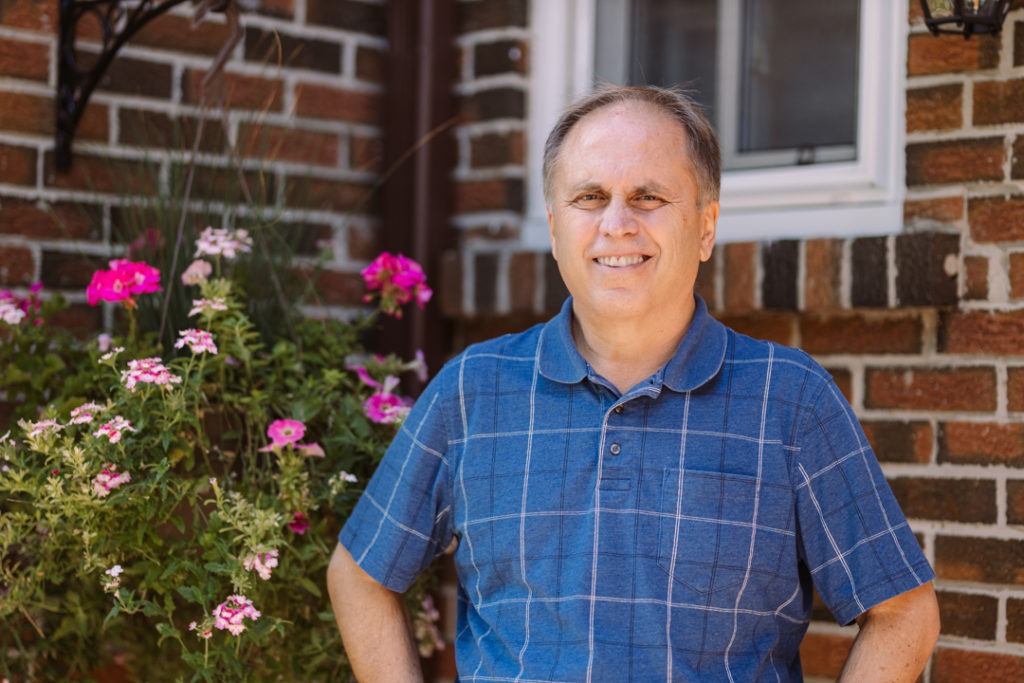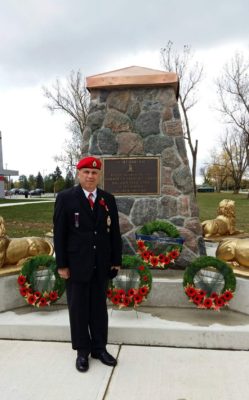
HHS patient soldiers on with virtual pain program
Bob Smith is a decorated Military Police veteran. During his 22 years with the Canadian Forces, he lost comrades on overseas missions, survived a helicopter crash and worked at a plane crash site recovering soldiers’ remains.
Now retired and living in Mississauga, Smith continues to face significant, life-altering challenges – this time with his health. “A lot of days, my pain is at a 10-plus on a scale of one to 10.”
Smith’s chronic pain is caused by osteoarthritis and exacerbated by other conditions including Type 2 diabetes and post-traumatic stress disorder (PTSD). He recently participated in a virtual pain management program at Hamilton Health Sciences’ (HHS) Michael G. DeGroote Pain Clinic.
“I feel that it had a positive effect.”
Pain programs had been offered in-person until COVID-19, and then staff pivoted to a virtual format due to the pandemic.
“Many virtual care opportunities are being explored at HHS,” says Lucas Milinovich, director of urgent and ambulatory care, who leads the hospital’s Virtual Care Operations Team.”The pandemic has pushed us to rethink how we provide care beyond our hospital walls. Through programs like these, patients are receiving care from the comfort of their own homes. This is patient-centred care in action.”
Virtual pain management programs
Two group-based programs are currently offered virtually: the Eight-Day Program and the Intensive Program. Both require referrals and an assessment to participate.
“Our programming, now offered through Zoom video conferencing, teaches people coping skills to better manage their pain,” says clinic coordinator Susy Faria.
The Eight-Day Program, covered by OHIP, requires a referral from a family doctor. It takes place once a week for eight weeks. Each session is about three hours long and includes a group physiotherapy class, an education group, a goal discussion and a relaxation class.
It aims to improve participants’ understanding of chronic pain and the factors that influence their ability to live a healthier, more active lifestyle. Participants learn ways to identify, manage and reduce stress and tension, and the basics of pain management.
The Intensive Program takes place Monday to Friday from 9:30 a.m. to 3:30 p.m. for four consecutive weeks, and requires a referral from either a family doctor, lawyer, rehabilitation consultant, insurance company, Veterans Affairs, the Workplace and Safety and Insurance Board or other health care professional. This service is not offered through OHIP so in order to be eligible, assessment and treatment costs must be pre-authorized by an insurance company, Veterans Affairs, the Workplace Safety and Insurance Board or other funding agency.
The Intensive Program offers 100-plus hours of treatment, where participants are involved in group physiotherapy, education sessions, case management, Yoga, Tai Chi, and individual therapy with each of the team members throughout their four weeks of treatment. This team includes a pain physician, pharmacist, psychologist, psychometrist, occupational therapists, physiotherapists, social workers and dietitian.
Learning helpful coping strategies
 Smith completed the virtual Intensive Program over the summer. “It helped me better manage my pain,” he says. “I feel that it had a positive effect.”
Smith completed the virtual Intensive Program over the summer. “It helped me better manage my pain,” he says. “I feel that it had a positive effect.”
Smith says that PTSD and other health issues make his osteoarthritis pain worse. Early in his military career, he walked away from a helicopter crash with minor injuries but the experience left him with nightmares.
“It was like going on your worst roller coaster ride,” he says.
A decade later he was at another crash site, this time recovering bodies of more than 200 U.S. soldiers at the Gander Arrow Air crash site. And he lost friends and comrades during his military career. All these traumatic experiences have taken an emotional toll.
“We would lend each other moral support.”
Before enrolling in Intensive Program, Smith had been going to bed at noon due to exhaustion and pain. “It was a struggle to keep the eyelids up.”
But he pushed through these challenges to participate. He especially appreciated the opportunity to connect with other patients trying to manage their pain.
“We would lend each other moral support and I think that had a positive effect,” he says
He also enjoyed the instructors. “They were very likable and made it easier to wrap our heads around the exercises we were following on Zoom.”
Smith takes several pills a day for a variety of health issues, and the program’s pharmacist helped him fine-tune his medication regimen. The program’s psychologist taught breathing exercises that helped him with relaxation.
You’re not alone
Hamilton poet and parent Elizabeth Ross also enjoyed connecting with other patients through the pain clinic. She recently completed the virtual Eight-Day Program to help manage chronic pain from a car crash.
“It made me recognize I wasn’t alone in this,” she says. “We were all in this chronic pain situation together and trying to make the best of it. The program helped me better understand what was happening with my body and have compassion for myself.”
Ross says she initially felt skeptical about the virtual format. “But in retrospect, I definitely see how helpful it was to do the program virtually from home. I could make lunch for my kids during breaks. Or if I was having a bad pain day, I could lie down and rest at home and still participate in the program.”
“Getting better might not mean the pain goes away.”
While programs can’t make pain disappear, patients learn valuable coping strategies.
“That was my biggest takeaway,” says Ross. “Getting better might not mean the pain goes away. Instead, it could mean learning to manage it better.”
Smith agrees. “Nobody has any magic wands to get rid of pain, but we can learn ways to help take the edge off.”
Once COVID-19 passes, Faria expects virtual programming to continue.
“I think there are many advantages to virtual programming,” she says, “especially for people who don’t live in the Hamilton area, because they can participate from the comfort of their own home. Our team envisions a hybrid model in the future, where people can choose between virtual and in-person programming.”
Anyone interested in taking part in virtual HHS virtual pain programs should talk to their family doctor or specialist as a first step.
